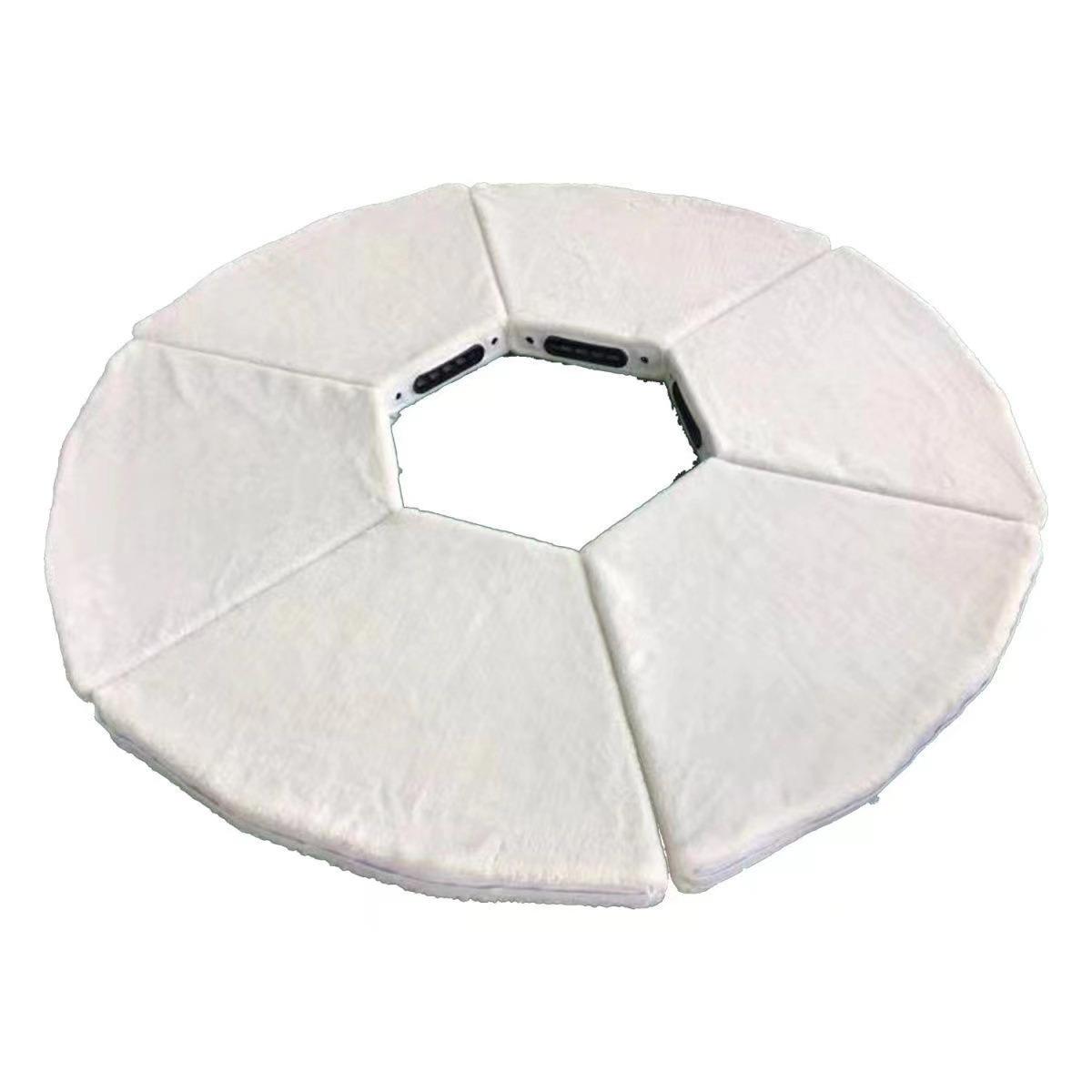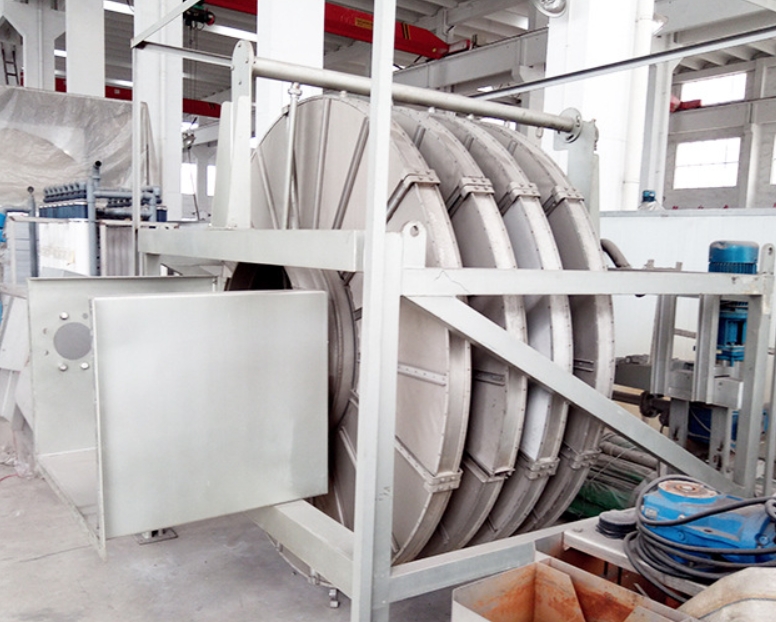
Rotary vacuum disc filter cloth(RVDF) is an essential component used in vacuum disc filters, which are widely utilized in industries such as mining, chemical processing, food and beverage production, and wastewater treatment. The primary function of the vacuum disc filter cloth is to facilitate the separation of solids from liquids through filtration
Polyester (PET): Known for its excellent mechanical strength, chemical resistance, and durability. Suitable for high-temperature applications.
Polypropylene (PP): Offers high resistance to acids and alkalis, making it ideal for chemical processing industries.
Nylon: Provides superior abrasion resistance and elasticity, suitable for applications requiring high tensile strength.
2. Structural Design:
Multi-layer Construction: Typically composed of multiple layers of fabric, each serving a specific purpose, such as filtration, support, and drainage. The layered design enhances overall filtration efficiency and durability.
Pore Size and Weave Pattern: Available in various pore sizes and weave patterns (plain weave, twill weave, and satin weave) to meet different filtration requirements. The choice of pore size and weave pattern affects the flow rate, filtration efficiency, and cake release properties.
3. Physical Properties:
Thickness: Ranges from 1.0 mm to 2.5 mm, depending on the application and required filtration efficiency.
Weight: Typically between 300 to 900 grams per square meter (gsm), with heavier fabrics offering greater durability and filtration capacity.
Permeability: Measured in terms of air permeability (CFM), it determines the rate at which liquid can pass through the cloth. Higher permeability is suited for applications requiring faster filtration rates.
4. Treatment and Finishing:
Calendering: A process of passing the fabric through heated rollers to smooth and compact the surface, enhancing cake release and reducing blinding.
Heat Setting: Stabilizes the fabric dimensions, improving structural integrity and performance under varying temperatures.
Edge Reinforcement: Provides additional strength to the edges, preventing fraying and extending the lifespan of the filter cloth.
Polyester (PET): Known for its excellent mechanical strength, chemical resistance, and durability. Suitable for high-temperature applications.
Polypropylene (PP): Offers high resistance to acids and alkalis, making it ideal for chemical processing industries.
Nylon: Provides superior abrasion resistance and elasticity, suitable for applications requiring high tensile strength.
2. Structural Design:
Multi-layer Construction: Typically composed of multiple layers of fabric, each serving a specific purpose, such as filtration, support, and drainage. The layered design enhances overall filtration efficiency and durability.
Pore Size and Weave Pattern: Available in various pore sizes and weave patterns (plain weave, twill weave, and satin weave) to meet different filtration requirements. The choice of pore size and weave pattern affects the flow rate, filtration efficiency, and cake release properties.
3. Physical Properties:
Thickness: Ranges from 1.0 mm to 2.5 mm, depending on the application and required filtration efficiency.
Weight: Typically between 300 to 900 grams per square meter (gsm), with heavier fabrics offering greater durability and filtration capacity.
Permeability: Measured in terms of air permeability (CFM), it determines the rate at which liquid can pass through the cloth. Higher permeability is suited for applications requiring faster filtration rates.
4. Treatment and Finishing:
Calendering: A process of passing the fabric through heated rollers to smooth and compact the surface, enhancing cake release and reducing blinding.
Heat Setting: Stabilizes the fabric dimensions, improving structural integrity and performance under varying temperatures.
Edge Reinforcement: Provides additional strength to the edges, preventing fraying and extending the lifespan of the filter cloth.

1. High Filtration Efficiency:
The multi-layer design and optimized pore size ensure effective separation of solids from liquids, producing high-quality filtrate and dry filter cake.
2. Durability and Chemical Resistance:
Made from high-quality synthetic fibers, the cloth exhibits excellent resistance to wear, tear, and chemical degradation, suitable for harsh industrial environments.
3. Easy Cake Release:
Treated surfaces facilitate easy removal of the filter cake, reducing downtime and maintenance efforts.
4. Customization:
Available in various sizes, shapes, and configurations to fit different types of vacuum disc filters and meet specific industrial requirements.
1. High Filtration Efficiency:
The multi-layer design and optimized pore size ensure effective separation of solids from liquids, producing high-quality filtrate and dry filter cake.
2. Durability and Chemical Resistance:
Made from high-quality synthetic fibers, the cloth exhibits excellent resistance to wear, tear, and chemical degradation, suitable for harsh industrial environments.
3. Easy Cake Release:
Treated surfaces facilitate easy removal of the filter cake, reducing downtime and maintenance efforts.
4. Customization:
Available in various sizes, shapes, and configurations to fit different types of vacuum disc filters and meet specific industrial requirements.
1. Mining Industry:
Used in the dewatering of mineral concentrates, tailings, and other slurries, ensuring efficient recovery of valuable minerals and reducing waste volume.
2. Chemical Processing:
Facilitates the filtration of chemical solutions, removal of impurities, and recovery of catalysts in processes such as leaching, precipitation, and crystallization.
3. Food and Beverage Industry:
Ensures the clarity and purity of liquids such as juices, wines, and syrups by removing suspended solids and impurities.
4. Wastewater Treatment:
Plays a crucial role in the dewatering of sludge, reducing the volume of waste and enhancing the efficiency of water treatment plants.
1. Mining Industry:
Used in the dewatering of mineral concentrates, tailings, and other slurries, ensuring efficient recovery of valuable minerals and reducing waste volume.
2. Chemical Processing:
Facilitates the filtration of chemical solutions, removal of impurities, and recovery of catalysts in processes such as leaching, precipitation, and crystallization.
3. Food and Beverage Industry:
Ensures the clarity and purity of liquids such as juices, wines, and syrups by removing suspended solids and impurities.
4. Wastewater Treatment:
Plays a crucial role in the dewatering of sludge, reducing the volume of waste and enhancing the efficiency of water treatment plants.